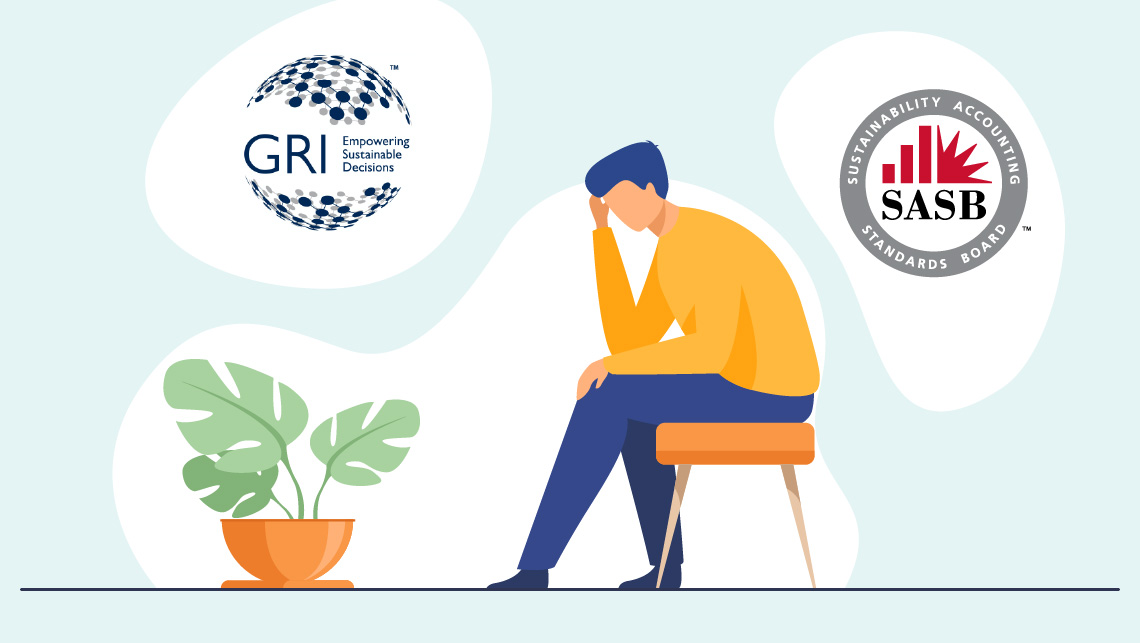
The goal is always to move a company on in their ESG journey whilst helping them navigate a complicated reporting landscape.
Stay informed with regulations, insights & events by joining our mailer
It’s a tough time for those charged with ESG reporting. I talk to so many clients who are struggling with the maze of frameworks they should report against, regulations they should comply with, ESG indexes they should follow and sustainability-conscious investors they should engage with.
At Design Portfolio, we certainly sympathise with you, and we strive to guide you through this maze. However, when news that two goliaths in the ESG reporting world are uniting, surely this is a time for celebration and a sigh of relief? Well, hold the champagne; in this blog we are going to look at what the 13 July GRI and SASB collaboration really means.
Who is who? And why now?
GRI, formerly the Global Reporting Initiative, and the Sustainability Accounting Standards Board, better known as SASB, are two leading standard setting agencies for sustainability reporting. Historically they have had an interesting relationship, with some level of competition in the past but also some efforts to achieve alignment. Now this has all changed as both will work together to provide guidance to companies about how to implement both of their ESG reporting standards concurrently.
The new collaboration has been driven by a number of factors:
- With a growing focus on ESG metrics by the mainstream investor community, there have been complaints of an alphabet soup of ESG guidance, with the likes of SDG, CDP, SASB, GRI, TCFD and more. Now more than ever, there is a need for creating a set of dominant standards to emerge.
- The increasing importance of companies' internal sustainability departments has meant more need for consistency of metrics. I have seen it first hand where a company's sustainability representative has had to juggle different figures to suit different departments' requirements, causing a confused and ineffective presentation of the company's ESG performance.
- Wider external stakeholders are seeking easily understandable and comparable data about companies' sustainability performance.
- And finally, COVID-19. The pandemic has put a brighter spotlight on companies' approaches to risk management and non-financial reporting, particularly in areas such as human capital management, biodiversity and supply chain.
Janine Guillot, CEO of SASB, says:
"The pandemic has demonstrated that so-called 'non-financial' information can indeed highlight material financial implications."
So, what's happening?
Things will likely be slow. The first stage of the collaboration will be a period of understanding.
For now, the two organisations’ work together will focus on going into the marketplace with harmonised, complementary messages. In the background, research will be conducted to look at how companies use the different standards.
The next step will be to look at best practice case studies of companies which are reporting against both standards and understand why they're doing it and what kind of information each provides for stakeholders. GRI and SASB will also develop examples based on real-world reports that demonstrate how the standards can be used together. These resources are planned to be delivered before the end of 2020.
Other than this, the detail on future collaborations and projects is still unclear; however, we at Design Portfolio will be sure to let you know if anything new comes to light.
Materiality prevails
It’s safe to say that any significant change and simplification of ESG reporting requirements is far off and will move slowly. However, one element of consistency across GRI and SASB is transparency. This is the best currency for creating trust among organisations and their stakeholders.
This is why taking the first step to simply define materiality is critical. Companies must make life simple for confused investors and clearly present to them the most material issues which impact their long-term sustainability. These issues should be supported with contextual data and an explanation as to how stakeholders have been engaged. A roadmap should then be presented as to how the company plans to track progress against these issues and ensure value is created for all key stakeholders in the long term.
This is where we can help. Design Portfolio provides a full suite of ESG consultancy services including materiality assessments. These can be tailored to a client’s needs and budgets. The goal is always to move a company on in their ESG journey whilst helping them navigate a complicated reporting landscape.
Do contact us at sustainability@design-portfolio.co.uk for a virtual chat to find out more.